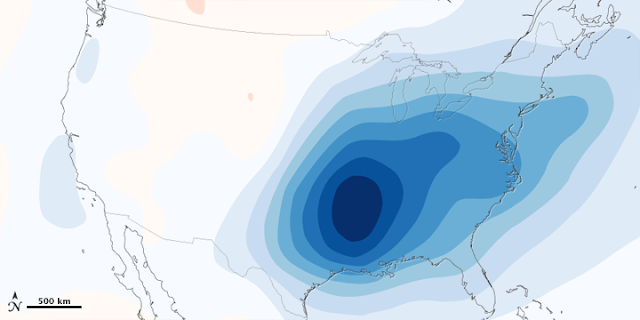Two maps that I discovered yesterday while following an live-stream event Designing Geopolitics 2 via twitter. For those of you who have interest in those questions of sovereignties, infrastructures and identities go to twitter (if you have a twitter account) and check out #desgeo2012 for more details. Tweets are available there with links of notes taken by the participants.
These two maps are a measure of how worrying threat of temperature rising is. They show a "warming hole" over the eastern United States due to air pollution, as reported in the Earth Observatory. The first map is designed based on data from NASA's Surface Temperature Analysis (GISTEMP), parts of the United States even cooled between 1930 and 1990.
 |
| Surface Air Temperature Change Due To Aerosols (°C). Originally appeared Earth Observatory. |
The Earth Observatory describes this map as follows:
Areas of the greatest cooling are blue; those that warmed are red.Very easy to understand. According to climate specialists, this large area of cooling is known as "warming hole", because:
[T]he areas surrounding it have warmed at a faster rate.Environment specialists' diverse studies show that natural variations in sea surface temperatures as well as sulfates — a type of aerosol —, produced by coal power plants. As the Earth Observatory notes, this aerosol is:
[K]nown for causing acid rain.As seen in the first map Surface Air Temperature Change Due To Aerosols, sulfates are in light-colored. Not only do these sulfates produce cooling by scattering and reflecting sunlight, but also, they lower temperatures indirectly by making clouds more reflective and long-lasting, we learn.
The second map observes surface temperature change as its title Observed Surface Temperature Change indicates. This research is led by a former researcher of the Harvard University, — now researcher at the MIT. With his team, Eric Leibensperger used global models to estimate the cooling effect sulfates on the climate of the United States since 1950. The team notes that between 1970 and 1990 sulfates were at their highest levels. This impacted temperature with nearly 1°Celsius (1.8° Fahrenheit) cooler in areas such as Arkansas and Missoury. For the Midwest and Mid-Atlantic, the researchers recorded temperatures being about 0.7°Celsius cooler. Sulfates also impacted sea surface temperatures with 0.3°Celsius cooler.
 |
| Observed Surface Temperature Change (°C). Originally appeared on Earth Observatory. |
temperatures over the central and eastern United States have increased 0.3°Celsius between 1980 and 2010.Additionally, these researchers note that given that sulfate concentrations have decreased sharply, the impact of future decreases won't be nearly as substantial.
What I learn from these maps is that environmental crises may be if not impossible at least tough to solve. As it has been said at the Designing Geopolitics 2 event:
Problems we're faced with are complex, demand cooperative solutions between people who never will agree.In this respect, global warming — I am afraid to add food security, water, natural resource shortage, and other environmental crises — can be viewed as a "super wicked problem", as one of the participants of this event noted, that is: a problem, to paraphrase Wikipedia, that is difficult or impossible to solve because of incomplete, contradictory, and changing requirements that are often difficult to recognize. In this context, I am wondering how we will problem-solve, or at least, do with environmental crises, not to become pessimistic, but…
Source: Earth Observatory


No comments:
Post a Comment